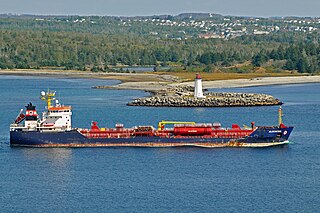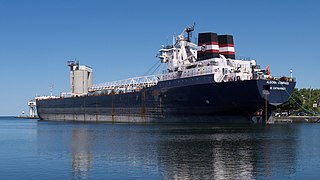Quebecois was a lake freighter that served the Great Lakes, operating between ports in the United States and Canada. The vessel was launched in 1962 by Canadian Vickers Ltd of Montreal, Quebec, Canada. Used to carry grain and ore, Quebecois was built to the maximum dimensions allowed on the Saint Lawrence Seaway. The vessel entered service in 1963 and in 2012, the ship's named was altered to Algoma Quebecois. The ship was broken up for scrap at Port Colborne, Ontario, Canada in 2013.

MV Algocape was a Canadian lake freighter operated by Algoma Central Corp. Initially constructed for Canada Steamship Lines as Richelieu, the ship was sold to Algoma Central Corp in 2004 and renamed Algocape. In 2012, the ship was sold again to Dido Steel Corporation and renamed Goc and broken up for scrap.

MV Tim S. Dool is an Algoma Central-owned seawaymax lake freighter built in 1967, by the Saint John Shipbuilding and Dry Dock Co. in Saint John, New Brunswick. She initially entered service as Senneville when she sailed as part of the fleet of Mohawk Navigation Company. Senneville was the second lake freighter constructed with a single superstructure at the stern. In 1981, the ship was sold to Pioneer Shipping. That company sold the vessel to Algoma Central in 1994 who renamed the ship Algoville. The bulk carrier got her current name in 2008. Tim S. Dool is currently in active service on the Great Lakes of North America.

MV Algonorth was a Seawaymax lake freighter built in 1970 and completed in 1971 by the Govan Division of Upper Clyde Shipbuilders Ltd. in Govan, Scotland as the bulk carrier Temple Bar. Her original owners were Lambert Bros. Shipping Ltd., of London, United Kingdom, sold the vessel in 1976 to Nipigon Transport Ltd., who had her hull lengthened and installed a new power plant for Great Lakes service. Re-entering service as Lake Nipigon, the ship was renamed Laketon in 1984 before returning to the name Lake Nipigon in 1986. In 1987, the lake freighter was sold to Algoma Central Railway which gave the ship its final named, Algonorth. In 2007, the ship collided with a dock in Toledo, Ohio. The ship was scrapped in 2012.

Algonova is double-hulled tanker built for Algoma Tankers Limited, a subsidiary of Algoma Central. The tanker's construction began in 2006 at Ereğli Shipyard in Turkey as Eregli 04. The ship was launched in 2008 as Algonova after the tanker was purchased by Algoma Tankers Limited while still under construction. The ship services ports on the Great Lakes and the Saint Lawrence Seaway. Algonova is the second ship to bear the name.
Algonova was a single-hulled oil tanker launched in 1969 as Texaco Chief for Texaco Canada Ltd. In 1986, the ship was renamed A. G. Farquharson. In 1995 the ship was sold to Imperial Oil. Purchased by Algoma Central in 1998, the ship was renamed Algonova. In 2007, Algoma Central sold the vessel to Belgrave Investors Corporation, which renamed the vessel Pacifico Trader. Helmer Business Incorporated acquired the vessel in 2012 and renamed the ship Great Portobello. The vessel is currently in active service.

Algorail was a lake freighter owned and operated by Algoma Central. The ship was built by Collingwood Shipyards in Collingwood, Ontario and was launched in 1967. The ship sailed on the North American Great Lakes and the Saint Lawrence Seaway delivering coal/coke, aggregates, slag, iron ore/oxides, salt, fertilizers, grain products, gypsum, quartzite, or sand. The ship was laid up in 2016 and sold for scrap in 2018.

English River was a lake freighter and bulk carrier, launched in 1961 by Collingwood Shipyards of Collingwood, Ontario. In her initial years she carried bulk cargoes and deck cargoes to smaller ports on the Great Lakes and Saint Lawrence River watershed and estuary. In 1973, the vessel was converted into a cement carrier and carried mainly raw cement for the construction industry. The ship continued to operate until English River was removed from service and sold for scrap.

The lake freighter MV Saginaw was launched as John J. Boland in 1953, the third vessel to bear that name. John J. Boland was owned and operated by the American Steamship Company and constructed by Manitowoc Shipbuilding Company at Manitowoc, Wisconsin. In 1999, the ship was sold to Lower Lakes Towing and renamed Saginaw. The ship is currently in service.

Baie Comeau is the fourth and last self-unloading lake freighter in Canada Steamship Lines (CSL) Trillium class. Like her sister ships, Baie St. Paul, Thunder Bay, and Whitefish Bay she was built in China, being launched in 2012 and entered service in 2013.

Algoma Progress was a self-unloading lake freighter and bulk carrier operating on the North American Great Lakes, owned by Algoma Central. Launched in 1968, the ship was originally named Canadian Progress and operated by the Upper Lakes Shipping. At launch, the ship was the largest self-unloading vessel on the Great Lakes. Canadian Progress was used to transport coal, iron ore, barley and road salt on the Great Lakes and Saint Lawrence Seaway. Canadian Progress ran aground twice, the first in 1985 and then again in 1988. In 2011, Upper Lakes Shipping sold its entire fleet to Algoma Central, which renamed the vessel Algoma Progress. In 2014, Algoma Progress was sold for scrap and broken up at Port Colborne, Ontario.

Algoma Compass, formerly Roger M. Kyes and Adam E. Cornelius, is a self-unloading bulk carrier built in Toledo, Ohio in 1973 for the American Steamship Company. The bulk carrier carried bulk cargoes throughout the Great Lakes and St. Lawrence Seaway. The vessel has earned a reputation as a "hard luck" ship, experiencing mechanical failures and groundings. In 2018, the ship was acquired by Algoma Central and put in service as Algoma Compass.
Algoma Navigator was a Canadian bulk carrier operated by Algoma Central. Like other bulk carriers, her potential cargoes included: coal/coke, aggregates, slag, iron ore/oxides, salt, fertilizers, grain products, gypsum, quartzite, or sand. The vessel was constructed by John Readhead & Sons in the United Kingdom in 1967 for the Cambay Steamship Company and launched as Demeterton. The vessel was enlarged in 1967 and sold in 1975 to the Upper Lakes Group which renamed the ship St. Lawrence Navigator. In 1979, the vessel was renamed Canadian Navigator after a rebuild. In 2011, the ship was sold to Algoma and became Algoma Navigator. In 2016, the bulk carrier was renamed Navi before being sold for scrap and broken up in 2016.

MV John J. Boland is a diesel-powered lake freighter owned and operated by the Buffalo-based American Steamship Company (ASC), a subsidiary of Rand Logistics. This vessel was built in 1973 at Bay Shipbuilding Company, Sturgeon Bay, Wisconsin. Initially named Charles E. Wilson, the vessel was renamed to its current name in 2000.

Algosteel was a bulk carrier owned and operated by Algoma Central. The vessel was constructed in 1966 by Davie Shipbuilding at their yard in Lauzon, Quebec for Canada Steamship Lines and launched as A.S. Glossbrenner. In 1968, the vessel was acquired by the Labrador Steamship Company. In 1971, the ship was sold to Algoma Central. The vessel's name was changed to Algogulf in 1987 and to Algosteel in 1990. The bulk carrier primarily transported iron ore and grain along the Saint Lawrence Seaway and the Great Lakes. The vessel was taken out of service in April 2018 pending disposal and was scrapped in Aliağa, Turkey, in 2018 under the name Oste.

The Trillium class is a series of freighters owned by Canada Steamship Lines (CSL). The class is divided into three subclasses; the self-discharging lake freighters, the lake bulk carriers, and the Panamax self-discharging bulk carriers. Initially a nine-ship building program, six are operated by Canada Steamship Lines for use on the Great Lakes, while three are operated by CSL Americas for international trade. Two more ships were acquired later for use by CSL Americas.

Radcliffe R. Latimer is a lake freighter launched in 1978. The vessel is owned by Algoma Central but operated under charter to Canada Steamship Lines from 1994 to 1997. As Algobay, the bulk carrier was involved in a collision with another lake freighter in 1980. In 2009 the vessel was rebuilt in China for service in the Caribbean Sea. The vessel is currently in service.

Algoma Provider was a Canadian lake freighter, which operated from 1963 to 2013 under the flag of several shipping lines. She was built to seawaymax dimensions at the Collingwood Shipyards in Collingwood, Ontario for Canada Steamship Lines. She was powered by a steam turbine, and was the company's last steam-powered vessel. Initially named Murray Bay, the ship was sold in 1994 to Upper Lakes Shipping, which renamed the vessel Canadian Provider. In 2011, Upper Lakes Shipping sold its entire fleet to Algoma Central, which renamed the lake freighter Algoma Provider. The vessel continued in service until 2013, when she was sold to be broken up for scrap. The ship was renamed Ovi for her journey to the scrapyard in Turkey. During her career, the ship carried bulk cargoes to destinations along the Saint Lawrence Seaway and Great Lakes.

Algosoo was a lake freighter constructed for Algoma Central in 1974 by Collingwood Shipyard in Collingwood, Ontario. The second ship of the name, Algosoo was the last lake freighter built in the traditional design for use on the North American Great Lakes, where the bridge topped a superstructure right in the ship's bow, and a second superstructure topped her engines, right in the stern. The vessel was used to transport bulk cargoes between ports on the Great Lakes. In 1986, the ship suffered a serious fire and 1994, was forced to run aground. Algosoo transported her last cargo in late 2015 and was sailed to the breaking yard at Port Colborne, Ontario in October 2016.

MV Mark W. Barker is a large diesel-powered lake freighter owned and operated by the Interlake Steamship Company. She is the first of the River-class freighters constructed for an American shipping company. MV Mark W. Barker is the first ship on the Great Lakes to be powered with engines that meet EPA Tier 4 standards. It is the first U.S.-flagged, Jones Act-compliant ship built on the Great Lakes since 1983.
















